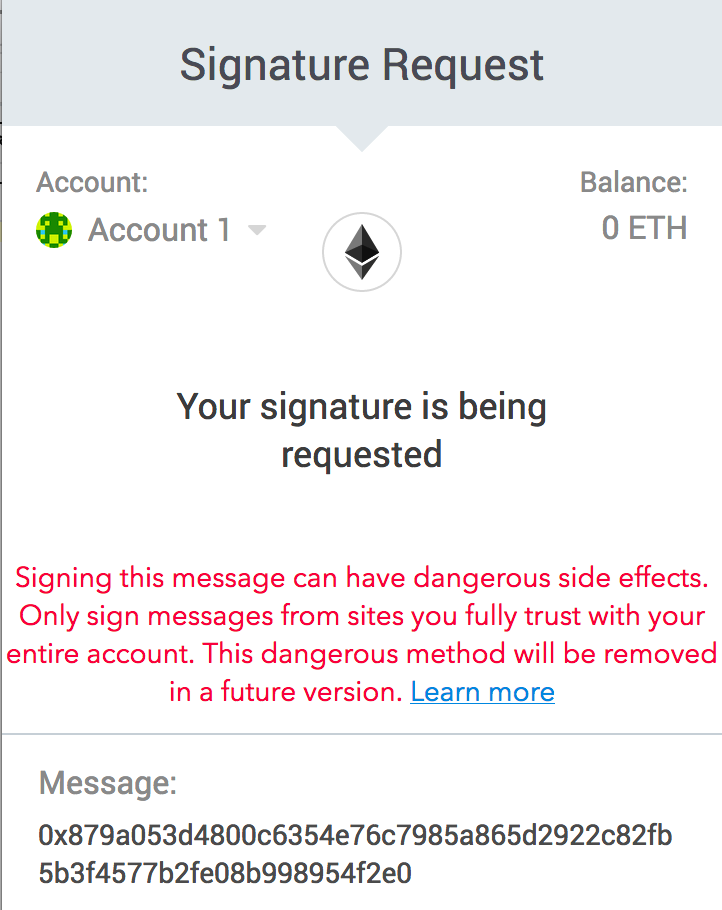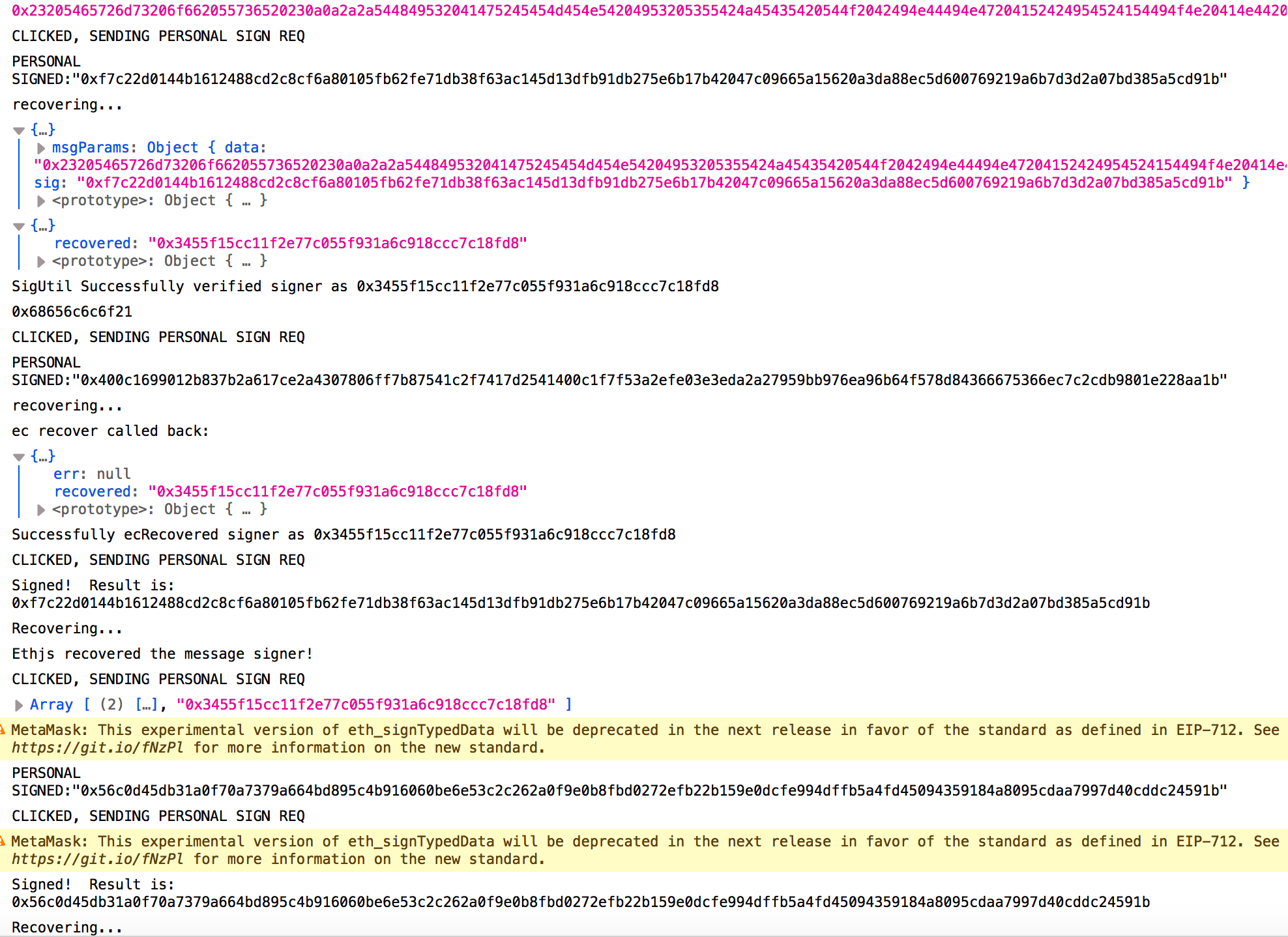Signature Request Warnings & eth_sign学习
https://consensys.zendesk.com/hc/en-us/articles/360004427792-Signature-Request-Warnings-eth-sign
MetaMask helps you manage your Ethereum private keys. As you probably know, you can use these keys to sign transactions that send Ether or ERC20 tokens from one account to another. But you can also use these keys to sign data presented to you by an application. This is powerful: signing data can prove ownership of your account and act as a form of authentication, user consent, or messaging.
metamask帮助我们管理以太坊私钥,我们可以使用这些key去对从一个账户到另一个账户之间的ether和ERC20 tokens交易进行签名。除此之外你还可以使用它来在应用中签署数据来代表你的身份。这是十分有用的,签署数据能够帮助我们证明我们对账户的拥有权或充当身份验证、用户同意或消息传递的形式
As Ethereum has evolved, the mechanics of asking users to sign data have evolved as well. For usability's sake, the community is trying to make data as clear and readable as possible when presented for signing. If an application asks a user to sign a Terms of Service with their private key, the user should be able to understand the content of what they're signing and trust its accuracy.
随着Ethereum的发展,要求用户签署数据的机制也在不断发展。出于可用性的考虑,社区正在努力使数据在提供签名时尽可能清晰和可读。如果应用程序要求用户用私钥签署服务条款,用户应该能够理解他们所签署的内容并相信其准确性。
For some older signing methods, this is not technically possible. When MetaMask encounters an application that asks for a signature on data in a format that's not human readable, we warn our users to sign only if they fully trust the application they are interacting with. In these cases, the balance of your wallet is at stake: it's possible for a malicious actor to encode a real transaction involving Eth or tokens inside the data, ask for your signature, and submit the transaction to the blockchain as if you had signed the transaction yourself.
对于一些较老的签名方法,这在技术上是不可能的。当MetaMask遇到要求对数据进行签名的应用程序时,该应用程序的格式不是人类可读的,我们警告用户只有在完全信任与之交互的应用程序时才签名。在这种情况下,你钱包的余额就岌岌可危了:恶意的参与者可能会对数据中涉及Eth或token的真实交易进行编码,请求您的签名,并将交易提交给区块链,就好像您自己签署了交易一样。

上图这种就是一种很老旧的签名方法,用户并不知道它签署的信息到底是什么
Some applications still rely on these older methods to interact with users, so we continue to support this type of signing functionality in our extension with a significant warning. In the long term we hope the Ethereum community will stop using these dangerous signing methods in favor of newer & safer alternatives.
有些应用程序仍然依赖这些较老的方法与用户交互,因此我们在扩展中继续支持这种签名功能,并发出了重要警告。从长远来看,我们希望Ethereum社区将停止使用这些危险的签约方式,支持更新和更安全的替代方案。

上图就是一种比较新的方法,在这里可以看见用户签署的信息
If you'd like to see how different signing methods interact with the MetaMask extension, check out these signing examples.
如果您想了解不同的签名方法如何与MetaMask扩展交互,请查看写在下面的这个实例中的这些方法:
有一个实现的例子:signing examples.
页面实现为:

这里面实现的代码都写在了bundle.js,从6506行可见对web3签署的API的调用,好好看看,了解人家是怎么实现的
后面学习之后发现实现代码是index.js,bundle.js是使用browserify将index.js转换成了浏览器能调用的格式的代码
var ethUtil = require('ethereumjs-util')
var sigUtil = require('eth-sig-util')
var Eth = require('ethjs')
window.Eth = Eth
var fs = require('fs')
var terms = fs.readFileSync(__dirname + '/terms.txt').toString()
ethSignButton.addEventListener('click', function(event) {
event.preventDefault() //阻止元素发生默认的行为(例如,当点击提交按钮时阻止对表单的提交)
var msg = '0x879a053d4800c6354e76c7985a865d2922c82fb5b3f4577b2fe08b998954f2e0'
var from = web3.eth.accounts[]
web3.eth.sign(from, msg, function (err, result) {
if (err) return console.error(err)
console.log('SIGNED:' + result)
})
})
personalSignButton.addEventListener('click', function(event) {
event.preventDefault()
var text = terms
var msg = ethUtil.bufferToHex(new Buffer(text, 'utf8'))
// var msg = '0x1' // hexEncode(text)
console.log(msg)
var from = web3.eth.accounts[]
/* web3.personal.sign not yet implemented!!!
* We're going to have to assemble the tx manually!
* This is what it would probably look like, though:
web3.personal.sign(msg, from) function (err, result) {
if (err) return console.error(err)
console.log('PERSONAL SIGNED:' + result)
})
*/
console.log('CLICKED, SENDING PERSONAL SIGN REQ')
var params = [msg, from]
var method = 'personal_sign'
web3.currentProvider.sendAsync({
method,
params,
from,
}, function (err, result) {
if (err) return console.error(err)
if (result.error) return console.error(result.error)
console.log('PERSONAL SIGNED:' + JSON.stringify(result.result))
console.log('recovering...')
const msgParams = { data: msg }
msgParams.sig = result.result
console.dir({ msgParams })
const recovered = sigUtil.recoverPersonalSignature(msgParams)
console.dir({ recovered })
if (recovered === from ) {
console.log('SigUtil Successfully verified signer as ' + from)
} else {
console.dir(recovered)
console.log('SigUtil Failed to verify signer when comparing ' + recovered.result + ' to ' + from)
console.log('Failed, comparing %s to %s', recovered, from)
}
/*
method = 'personal_ecRecover'
var params = [msg, result.result]
web3.currentProvider.sendAsync({
method,
params,
from,
}, function (err, recovered) {
console.dir({ err, recovered })
if (err) return console.error(err)
if (result.error) return console.error(result.error)
if (result.result === from ) {
console.log('Successfully verified signer as ' + from)
} else {
console.log('Failed to verify signer when comparing ' + result.result + ' to ' + from)
}
})
*/
})
})
personalRecoverTest.addEventListener('click', function(event) {
event.preventDefault()
var text = 'hello!'
var msg = ethUtil.bufferToHex(new Buffer(text, 'utf8'))
// var msg = '0x1' // hexEncode(text)
console.log(msg)
var from = web3.eth.accounts[]
/* web3.personal.sign not yet implemented!!!
* We're going to have to assemble the tx manually!
* This is what it would probably look like, though:
web3.personal.sign(msg, from) function (err, result) {
if (err) return console.error(err)
console.log('PERSONAL SIGNED:' + result)
})
*/
console.log('CLICKED, SENDING PERSONAL SIGN REQ')
var params = [msg, from]
var method = 'personal_sign'
web3.currentProvider.sendAsync({
method,
params,
from,
}, function (err, result) {
if (err) return console.error(err)
if (result.error) return console.error(result.error)
console.log('PERSONAL SIGNED:' + JSON.stringify(result.result))
console.log('recovering...')
const msgParams = { data: msg }
msgParams.sig = result.result
method = 'personal_ecRecover'
var params = [msg, result.result]
web3.currentProvider.sendAsync({
method,
params,
from,
}, function (err, result) {
var recovered = result.result
console.log('ec recover called back:')
console.dir({ err, recovered })
if (err) return console.error(err)
if (result.error) return console.error(result.error)
if (recovered === from ) {
console.log('Successfully ecRecovered signer as ' + from)
} else {
console.log('Failed to verify signer when comparing ' + result + ' to ' + from)
}
})
})
})
ethjsPersonalSignButton.addEventListener('click', function(event) {
event.preventDefault()
var text = terms
var msg = ethUtil.bufferToHex(new Buffer(text, 'utf8'))
var from = web3.eth.accounts[]
console.log('CLICKED, SENDING PERSONAL SIGN REQ')
var params = [from, msg]
// Now with Eth.js
var eth = new Eth(web3.currentProvider)
eth.personal_sign(msg, from)
.then((signed) => {
console.log('Signed! Result is: ', signed)
console.log('Recovering...')
return eth.personal_ecRecover(msg, signed)
})
.then((recovered) => {
if (recovered === from) {
console.log('Ethjs recovered the message signer!')
} else {
console.log('Ethjs failed to recover the message signer!')
console.dir({ recovered })
}
})
})
signTypedDataButton.addEventListener('click', function(event) {
event.preventDefault()
const msgParams = [
{
type: 'string',
name: 'Message',
value: 'Hi, Alice!'
},
{
type: 'uint32',
name: 'A number',
value: ''
}
]
var from = web3.eth.accounts[]
/* web3.eth.signTypedData not yet implemented!!!
* We're going to have to assemble the tx manually!
* This is what it would probably look like, though:
web3.eth.signTypedData(msg, from) function (err, result) {
if (err) return console.error(err)
console.log('PERSONAL SIGNED:' + result)
})
*/
console.log('CLICKED, SENDING PERSONAL SIGN REQ')
var params = [msgParams, from]
console.dir(params)
var method = 'eth_signTypedData'
web3.currentProvider.sendAsync({
method,
params,
from,
}, function (err, result) {
if (err) return console.dir(err)
if (result.error) {
alert(result.error.message)
}
if (result.error) return console.error(result)
console.log('PERSONAL SIGNED:' + JSON.stringify(result.result))
const recovered = sigUtil.recoverTypedSignature({ data: msgParams, sig: result.result })
if (recovered === from ) {
alert('Successfully ecRecovered signer as ' + from)
} else {
alert('Failed to verify signer when comparing ' + result + ' to ' + from)
}
})
})
ethjsSignTypedDataButton.addEventListener('click', function(event) {
event.preventDefault()
const msgParams = [
{
type: 'string',
name: 'Message',
value: 'Hi, Alice!'
},
{
type: 'uint32',
name: 'A number',
value: ''
}
]
var from = web3.eth.accounts[]
console.log('CLICKED, SENDING PERSONAL SIGN REQ')
var params = [msgParams, from]
var eth = new Eth(web3.currentProvider)
eth.signTypedData(msgParams, from)
.then((signed) => {
console.log('Signed! Result is: ', signed)
console.log('Recovering...')
const recovered = sigUtil.recoverTypedSignature({ data: msgParams, sig: signed })
if (recovered === from ) {
alert('Successfully ecRecovered signer as ' + from)
} else {
alert('Failed to verify signer when comparing ' + signed + ' to ' + from)
}
})
})
在运行的过程中我们能够看见我们进行签名的信息到底是什么
在页面控制器中的返回信息如下图所示:
点击eth_sign,metamask如图:

不能看见签署的信息到底是什么
而另外的几种新的签名方法都能够很详细地看见用户对什么信息进行了签名

Signature Request Warnings & eth_sign学习的更多相关文章
- Request模块入门学习
使用指令npm install --save request来安装模块,然后使用var request = require('request')完成引用. 对于GET请求,主要是获取目的url中数据. ...
- JSP内置对象之request对象【学习笔记】
request对象是JSP中重要的对象,每个request对象封装着一次用户的请求,并且所有的请求参数都被封装在request对象中,因此request对象是获取请求参数的重要途径. 一.获取请求头与 ...
- <c:set var="ctx" value="${pageContext.request.contextPath}" />的学习
${pageContext.request.contextPath},是获取当前根目录 set var="ctx",是给这个路径定义了一个变量,用的时候可以通过EL表达式获取:${ ...
- python+request 常用基础学习笔记
1.pycharm,避免控制台输出的json内容中文出现乱码. #注:乱码为Unicode格式:\u6d4b\u8bd5.加入如下代码后正确返回中文:测试 get_result = r.json() ...
- browerify初步了解
之前在写Signature Request Warnings & eth_sign学习的时候在里的signing examples时了解到browserify工具,可以通过这个例子学习如何使用 ...
- C#开发微信公众号-学习笔记
由于最近要做微信服务号的开发,所以开始找相关说明和接口文档开始学,故把学习过程及注意事项记录一下,帮助想学习的快速上手.废话不多少了,直接上干货! 1.申请微信公众号 这个就不需要多说了吧,大家直接照 ...
- java微信学习 接入
现在实习的公司要做微信开发,然而一直没安排任务,所以一直在看微信接口,记录下学习的内容 微信开发肯定要看的就是微信公众平台开发者文档,上面有每种接口的调用格式,刚开始学习的时候自己申请了一个订阅号,个 ...
- Core Data 学习简单整理01
Core Data是苹果针对Mac和iOS平台开发的一个框架, 通过CoreData可以在本地生成数据库sqlite,提供了ORM的功能,将对象和数据模型相互转换 . 通过Core Data管理和操作 ...
- webx学习
webx框架学习指南 http://openwebx.org/docs/Webx3_Guide_Book.html webx学习(一)——初识webx webx学习(二)——Webx Framewor ...
随机推荐
- ssr 之Nuxt.js
ssr:server side rendering(服务端渲染),目的是为了解决单页面应用的 SEO 的问题,对于一般网站影响不大,但是对于论坛类,内容类网站来说是致命的,搜索引擎无法抓取页面相关内容 ...
- Linux常用基本命令:三剑客命令之-awk 三元表达式
awk 3元表达式,if...else结构都可以用3元表达式改写 ghostwu@dev:~/linux/awk$ awk -v FS=":" '{ type=$3>=100 ...
- blfs(systemv版本)学习笔记-配置远程访问和管理lfs系统
我的邮箱地址:zytrenren@163.com欢迎大家交流学习纠错! 要实现远程管理和配置lfs系统需要配置以下软件包: 前几页章节脚本的配置:https://www.cnblogs.com/ren ...
- Docker 搭建 ELK 收集并展示 tomcat 日志
架构 前端展示 --> 索引搜索 <-- 日志提取及过滤 --> 日志缓存 <-- 日志收集 Kibana --> Elastash <-- Logstash -- ...
- 【代码笔记】Web-HTML-框架
一,效果图. 二,代码. <!DOCTYPE html> <html> <head> <meta charset="utf-8"> ...
- 02--css背景与边框--css揭秘
背景与边框 一 半透明边框 rgba/hsla颜色 1.难题 假设我们想给一个容器设置一层白色背景和一道半透明白色边框,body 的背景会从它的半透明边框透上来.我们最开始的尝试可能是这样的: #bo ...
- Linux Linux内核参数调优
Linux内核参数调优 by:授客 QQ:1033553122 关于调优的建议: 1.出错时,可以查看操作系统日志,可能会找到一些有用的信息 2.尽量不要“批量”修改内核参数,笔者就曾这么干过,结果“ ...
- beego+vue父子组件通信(父子页面传值、父子组件传值、父子路由传值)
场景:有head和foot,为父组件 侧栏tree为子组件 点击tree,右侧孙组件根据点击tree的id,来更改表格内容. 首先是父子(本例中是子组件与孙组件)通信,目前是父传到子,暂时还没有子传到 ...
- c++面向对象学习计划
面向对象自学计划 视频学习计划 计划:每天观看至少两个视频,到开学时差不多完成视频的学习. 进度:已学习12个视频. C的强化与补漏 C语言不熟悉的知识点:数组,结构体,链表,文件 -----已重新学 ...
- eclipse下载教程
Eclipse 是一个开放源代码的.基于 Java 的可扩展开发平台. Eclipse 是 Java 的集成开发环境(IDE),当然 Eclipse 也可以作为其他开发语言的集成开发环境,如C,C++ ...
